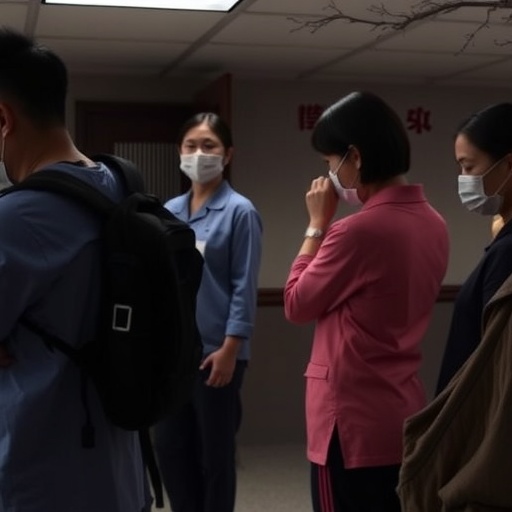In the landscape of next-generation photovoltaics, perovskite solar cells (PSCs) have emerged as a promising technology capable of delivering high efficiency at potentially low cost. A critical advancement in their performance has been the integration of hole-selective self-assembled monolayers (SAMs), which have pushed certified power conversion efficiencies (PCEs) to record highs. Nonetheless, despite their initial success, the inherent instability of these SAMs under operational stresses has presented a formidable challenge to the commercialization of inverted perovskite solar cells, limiting their practical viability. In a groundbreaking study published recently, researchers have unveiled a novel strategy employing cross-linkable co-SAMs, dramatically enhancing both the durability and performance of perovskite photovoltaics.
SAMs operate as ultra-thin, molecular-scale interfaces between the active perovskite layer and charge-extracting electrodes, selectively transporting holes while blocking electrons. This hole-selectivity, coupled with their ability to form well-ordered monolayers, facilitates efficient charge extraction and reduces interface recombination losses, which are pivotal for achieving high PCEs. Despite these advantages, the monolayer nature of SAMs inherently leaves them vulnerable to conformational fluctuations, especially under heat or mechanical stress, which can induce defects, voids, and ultimately perovskite degradation. Addressing these weaknesses has, until now, been a complex materials design problem often constrained by competing parameters such as film uniformity, orientation, and thermal stability.
The new work centers on a cross-linkable co-SAM incorporating azide functional groups, capable of undergoing thermally induced cross-linking reactions that transform the initially loose molecular assembly into a robust, densely packed network. This cross-linked structure displays significantly enhanced conformational stability, effectively immobilizing the SAM molecules to maintain a uniform and preferred orientation even at elevated temperatures. By eliminating the ‘wiggling’ or dynamic disorder that typically exposes vulnerable substrate sites, the cross-linked co-SAM prevents the onset of defect formation, crucially safeguarding the underlying perovskite from chemical decomposition.
Thermally activated cross-linking within the SAM is a clever molecular engineering feat that balances densely packed molecular order with the flexibility required during the self-assembly process. Before cross-linking, the co-SAMs self-assemble onto the substrate, ideally forming homogeneous films. Subsequent thermal treatment prompts azide groups to react and form covalent bonds between adjacent molecules, effectively ‘locking in’ the favorable conformations. This dual-stage fabrication approach ensures that the optimization of molecular packing and the enhancement of thermal durability are decoupled, enabling precise control over the interface’s nanostructure and chemistry.
Performance testing of devices incorporating these thermally cross-linked co-SAMs revealed a notable leap in both efficiency and longevity. The champion photovoltaic device achieved a certified power conversion efficiency of 26.92%, surpassing previous benchmarks in inverted perovskite solar cell architectures. Equally impressive was the thermal endurance of these cells; they exhibited near-zero decay in PCE after sustained operation at 85 °C under maximum power point tracking conditions for 1,000 hours. This endurance is an extraordinary metric in a field often plagued by rapid device degradation under thermal stress.
Further evidence of the robustness of this approach came from rigorous thermal cycling tests, in which the cells underwent 700 repetitive transitions between −40 °C and 85 °C. Despite the severe thermal shocks, the devices retained over 98% of their initial performance. Such stability through broad temperature fluctuations mirrors the demanding environmental conditions encountered in real-world outdoor applications, suggesting that the newly engineered co-SAM interfaces could bridge the gap between laboratory prototypes and consumer-ready solar technologies.
Beyond operational durability and efficiency, the study delved into the molecular degradation mechanisms that typically afflict SAM-based devices. Employing advanced characterization techniques, the researchers identified that traditional SAMs suffer from dynamic conformational instability that introduces substrate surface exposure and consequent chemical vulnerabilities in the perovskite film. The cross-linked co-SAM design counters these problems by maintaining a continuous, defect-suppressing monolayer that acts as a protective buffer. This insight provides a conceptual framework for future advances, emphasizing the critical role of interface molecular engineering in unlocking stable device architectures.
The ramifications of this research extend beyond just improved perovskite solar cells. The methodology of incorporating thermally cross-linkable functional groups within SAMs to tune their mechanical and chemical stability introduces a versatile platform potentially compatible with other optoelectronic devices reliant on molecular interfaces. Organic electronics, light-emitting diodes, and sensors may also benefit from adopting similar co-SAM designs, where interface robustness dictates device lifespan and performance consistency.
Moreover, the work addresses a common limitation in device fabrication imposed by substrate surface roughness. High roughness typically prevents the formation of uniform SAM coverage, resulting in pinholes and exposed regions vulnerable to environmental degradation. The densely cross-linked co-SAM network showcased here exhibits enhanced tolerance to such substrates, enabling its application on less ideal, more industrially relevant surfaces without compromising device integrity.
This advancement also highlights the importance of considering dynamic molecular behaviors in the design of functional coatings. Whereas prior approaches largely focused on the chemical composition or static morphological features of SAMs, this study pivots attention to the dynamic conformational stability under operational conditions—a more realistic reflection of device working environments. By anchoring molecular flexibility through cross-linking, the researchers unlock a new dimension in interface chemistry control.
Equally significant is the implication for scaling up manufacturing processes. The two-step approach—initial self-assembly followed by thermal activation—could be integrated into established solution-processing or vapor-deposition platforms with minimal disruption. The resulting benefit is a scalable yet finely tunable interface that promises to retain high device efficiency over prolonged operational timelines, a key demand for photovoltaic module commercialization.
In conclusion, the marriage of chemical innovation with precision interface engineering demonstrated in this study marks a pivotal stride towards achieving durable, high-performance perovskite solar cells. With a certified PCE approaching 27% and genuinely impressive thermal endurance, these cross-linked co-SAM-based devices set a new benchmark that aligns efficiency, stability, and manufacturability. As the photovoltaic community continues to push fronts in interface science, this approach will undoubtedly inspire further explorations into molecularly engineered protective layers, accelerating the transition of perovskite solar cells from lab curiosities to market-ready solutions.
Subject of Research: Durability enhancement of perovskite solar cells through chemically cross-linked hole-selective self-assembled monolayers
Article Title: Toughened self-assembled monolayers for durable perovskite solar cells
Article References:
Jiang, W., Qu, G., Huang, X. et al. Toughened self-assembled monolayers for durable perovskite solar cells. Nature (2025). https://doi.org/10.1038/s41586-025-09509-7
Image Credits: AI Generated




